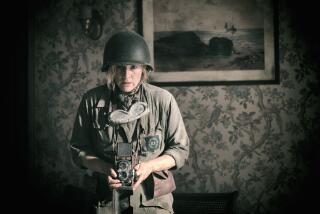‘Big Red’ given epic reworking
- Share via
“This is fictional life, based on factual death,” reads the title card that opens “The Big Red One: The Reconstruction,” the restoration that breathes new life into Samuel Fuller’s 1980 World War II movie about a weathered sergeant and his four fresh-faced charges. The writer-director wove his own experiences with the 1st Infantry Division -- whose distinctive crimson shoulder patch provides the film’s title -- with stories he’d heard to create a deeply personal, ground-level vision of men at war.
Produced by film historian and author Richard Schickel, the reconstituted edition of “The Big Red One” rolls through its nearly three hours with the martial efficiency of films half its length. The characters take on added depth, and the film’s episodic structure now boasts grand thematic arcs that solidify its narrative.
Originally released by Lorimar with a running time of less than two hours, “The Big Red One” received mostly mixed reviews but also claimed its supporters. Cinephiles dreamed of an extended version, particularly following Fuller’s 1997 death and the posthumous publication of his autobiography, “A Third Face,” in which he refers to a now thought to be apocryphal 4 1/2 -hour cut.
Schickel and editor Bryan McKenzie carefully assembled additional footage located in a vault in Kansas City, Mo., and, working from Fuller’s shooting script, created a cut that more closely represented Fuller’s vision. “The Reconstruction,” which clocks in at 2 hours, 43 minutes, with not a single extraneous frame, elevates the work from a robust genre film to a full-blown epic.
Lee Marvin’s nameless graybeard sergeant takes on tragic weight as the philosophy that ensures his survival also dooms him to repeat his mistakes. Beginning with the black-and-white prologue set in 1918 France (now flecked with a shot of a single scarlet “one”) to the film’s finale at the end of the Second World War, the man walks a moral line stressing that killing is not murder. That conviction stands at the story’s heart and drives home Fuller’s point that war’s only glory lies in surviving. The mind-set allows “the Sergeant and his Four Horsemen,” as he and his young squad are known, to fight another day.
Mark Hamill as Griff, the sharpshooter with a conscience; Robert Carradine as Zab, the Fuller stand-in, a cigar-chomping writer; Bobby Di Cicco as Vinci; and Kelly Ward as Johnson are the green dogfaces the sergeant takes under his wing. In battles across the European theater, the four become an extension of their non-com leader, their faces gradually taking on the same grim, nonchalance as Marvin’s character. Other than Zab, we learn very little about their backgrounds. It is the director’s attention to detail and the performances of the actors -- especially Hamill, who was midway through his run as Luke Skywalker at the time -- that create compelling characters. Fuller is more interested in contrasting the routine bits of business, the hurry-up-and-wait stasis of military life and the effect it has on the men, with their ongoing deadly struggle to stay one step ahead of the enemy.
Marvin’s performance, much enhanced by “The Reconstruction,” is a marvel. Gruff as ever, the character is a force of calm in the center of chaos. Economical with his words, he is a man of resolute action and stillness that command the men’s respect. He’s also a lightning rod for children wherever the fight takes the squad, as if the kids intuitively seek him out as a haven. The interactions provide the film with tender, unsentimental moments that allow emotion to seep in just at the edges.
While Fuller’s focus is on the drama of the banal amid the specter of death, he does not stint on action. There are suspense sequences that are as tense as any you will find. The director’s D-day set piece may be eclipsed as brutal spectacle by “Saving Private Ryan,” but not as military enterprise. The landing at Omaha Beach is depicted as a gut-wrenching effort enriched by the device of using a watch on a dead soldier’s wrist to depict the passing of time as the seawater around him becomes redder and redder. Fuller places at the center of the bedlam showcased in “Ryan” a taut sense of mission that perfectly encapsulates “The Big Red One’s” drive to complete a job while remaining alive.
*
‘The Big Red One: The Reconstruction’
MPAA rating: R for war violence and some language
Times guidelines: Some gore, lots of death and a shot of exposed intestines
Lee Marvin...Sergeant
Mark Hamill...Griff
Robert Carradine...Zab
A Warner Bros. presentation. Writer-director Samuel Fuller. Producer Gene Corman. Director of photography Adam Greenberg. Editor Morton Tubor. “Reconstruction” producer Richard Schickel. Executive in charge of production Brian Jamieson. Co-producer Doug Freeman. Editor Bryan McKenzie. Music Dana Karpoff. Running time: 2 hour, 43 minutes.
Exclusively at the Landmark Nuart, 11272 Santa Monica Blvd., West Los Angeles, (310) 281-8223. Schickel and Jamieson will appear tonight for the 8:30 show; Christa Fuller, the director’s widow, will appear Thursday night for the 8:30 show.
More to Read
Only good movies
Get the Indie Focus newsletter, Mark Olsen's weekly guide to the world of cinema.
You may occasionally receive promotional content from the Los Angeles Times.










